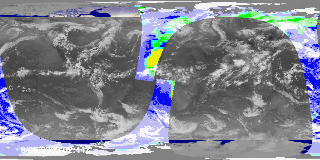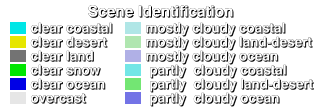|
|
 |
Scene Identification Compared to Clouds (WMS)
|
The Earth's climate is determined by energy transfer from the sun to the Earth's land, oceans, and atmosphere. As the Earth rotates, the sun lights up only part of the Earth at a time, and some of that incoming solar energy is reflected and some is absorbed, depending on type of area it lights. The amount of reflection and absorption is critical to the climate. An instrument named CERES orbits the Earth every 99 minutes and measures the reflected solar energy. This animation shows the scene identification as measured by CERES during 29 orbits on June 20 and 21 of 2003. By comparing the incoming solar radiation with the outgoing reflected and thermal radiation, it is possible to identify the type of area being viewed, whether it be land, clouds, ocean, or ice. This scene identification is used together with the radiation flux measurements to build up a complete picture of the Earth's energy budget over time.
|
|

|
|
This animation shows 29 orbits (2 days) of CERES measurements of regions of solar reflectivity, from June 20-21, 2003. The measurements are superimposed over a global infrared cloud cover composite from the same period.
Duration: 29.0 seconds
Available formats:
320x160
PNG
71 KB
160x80
PNG
20 KB
80x40
PNG
6 KB
640x320 (29.97 fps)
MPEG-1
5 MB
1024x512
Frames
How to play our movies
|
|
This product is available through our Web Map Service.
Click here to learn more.
|
|

|
|
This is the legend for the scene identification animation, indicating the discreet regions of solar reflectivity.
Available formats:
320 x 110
PNG
2 KB
|
|
|
Back to Top
|
|
|
|